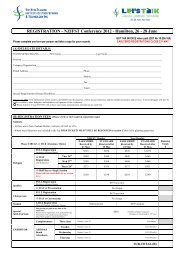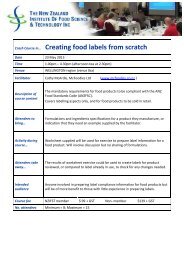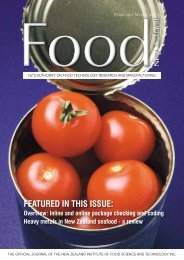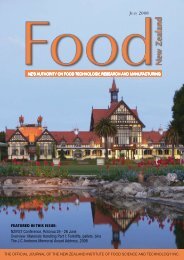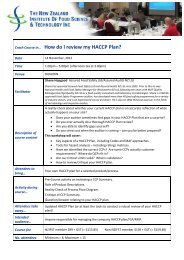FEATURED IN THIS ISSUE - NZIFST - The New Zealand Institute of ...
FEATURED IN THIS ISSUE - NZIFST - The New Zealand Institute of ...
FEATURED IN THIS ISSUE - NZIFST - The New Zealand Institute of ...
You also want an ePaper? Increase the reach of your titles
YUMPU automatically turns print PDFs into web optimized ePapers that Google loves.
as acrylamide in foods, and emerging pathogens.Consumer awareness <strong>of</strong> the links between diet and healthis also growing. Whereas ten years ago food safety and basicnutrition were the givens, consumers now expect safety andnutrition, and look additionally for some health benefit. This isfed by a desire to improve the quality and length <strong>of</strong> healthy lifeas the population progressively ages (See table 1).Life Expectancy at birth and healthy life expectancy at birth (Table 1).locationAn enormous amount <strong>of</strong> misinformation reaches both consumersand food specialists, exacerbated by the Internet, wherea good deal <strong>of</strong> information lacks scientific credibility and/orauthority. Consumers now expect to self-diagnose health problemsand they <strong>of</strong>ten seek magic bullet solutions which mayinclude food or drugs which probably don’t work.Retailers have enormous power and effectively control thegateway to the consumer, but have done little to embrace thetechnical considerations <strong>of</strong> processed foods in their drive formarket share and pr<strong>of</strong>it. Essentially, retail and supply are atodds with each other and the casualty can be food safety orquality. This lack <strong>of</strong> appreciation <strong>of</strong> the cost <strong>of</strong> safety and qualityassurance is most pronounced as the retail sector pressurisesmanufacturers’ margins, while continuously demanding moresophisticated products, such as minimally processed foods.Without a rigorous understanding <strong>of</strong> food technology, retailersare in danger <strong>of</strong> undermining the substantial achievements infood safety and quality that have been the hallmark <strong>of</strong> the foodindustry in the 20th century.our bodies get bigger. <strong>The</strong>re is now a major mismatch betweenfundamental scientific knowledge and its application in industry.<strong>New</strong> products with nutrition and health claims emerge intothe marketplace, yet the science underpinning these claims is atbest dubious and insufficiently robust.Challenges <strong>of</strong> this nature are not new. <strong>The</strong> process <strong>of</strong> discoveryand application, which accelerated greatly in the lastcentury, has been a feature <strong>of</strong> the human race. But the drivers2001 2002 2003 2004 2005 2006life health life health life health life health Life health life healthworld 66.4 54.7 66.5 56.9 66.7 57.3 66.9 57.8 67.1 58.3 67.3 58.7OECD 77.4 66.0 77.5 66.9 77.7 67.2 78.0 67.7 78.3 68.0 78.5 68.4EU 76.2 70.33 78.8 70.8 79.1 71.5 79.2 71.9 79.4 72.2 79.6 72.4Australia 79.3 71.6 79.6 72.6 79.8 73.2 79.9 73.5 80.1 73.9 80.4 74.2NZ 78.7 70.3 78.8 70.8 79.1 71.5 79.2 71.9 79.4 72.2 79.6 72.4(Euromonitor, 2007)<strong>of</strong> discovery have changed and the food industry must itselfevolve to meet the new demands. In the 20th century, muchtechnological change came from scientific discovery and itsapplication by the industry. Today, scientific discovery is be-JC Andrews Memorial Award 2007R&D expenditure is usually the firstcasualty <strong>of</strong> a tightening budgetIn manufacturing, R&D expenditure is usually the first casualty<strong>of</strong> a tightening budget, leaving technical services fullystretched with responsibility for both maintaining day-to-day activitiesand trouble-shooting. Opportunities for staff to up-skilland stay abreast <strong>of</strong> modern scientific developments are beingreduced all the time. Meanwhile novel technologies, new ingredientsand new product formats are being widely promoted asconsumers demand less processed foods, fewer additives andreduced levels <strong>of</strong> protective packaging. <strong>The</strong> combined outcomeis a reduction in the normal safety margins that exist in foodprocessing – and the real potential for a progressive increase infood-borne diseases.While we are gaining scientific knowledge about ingredients,especially bioactives and related so-called functional ingredients,the gaps in knowledge about how they interact inJuly 200717



